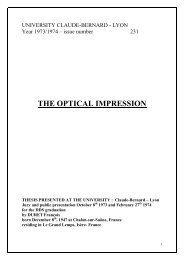english version(pg40to78) - Pr. François Duret
english version(pg40to78) - Pr. François Duret
english version(pg40to78) - Pr. François Duret
Create successful ePaper yourself
Turn your PDF publications into a flip-book with our unique Google optimized e-Paper software.
F <strong>Duret</strong> and Coll. <strong>Pr</strong>incipes de fonctionnement et applications techniques de l’empreinte optique dans l’exercice de cabinet<br />
(traduction Anglaise)<br />
Page 81<br />
READING SYSTEM<br />
The wave projection module can be constituted of :<br />
- a coherent or non coherent light source (laser), powerful enough<br />
to project the image of a regular weft on the tooth and for this<br />
weft to be perfectly detectable through another weft placed in<br />
front of the objective of the reading system;<br />
- one or more wefts with known profile and a great precision and<br />
dimensions thin enough to answer the prosthetic precision<br />
demands (less than 200µm);<br />
- a reading camera with a matricial DTC (Charge Transfer<br />
Device) with a least 60000 PEL (Image analysis elementary<br />
points).<br />
These DTC or CCD (Charge Coupled Device) (Fig. 11) deserve our<br />
attention as they represent the first limitation towards a good precision<br />
in the moiré methodology on the fundamental plan. Invented in 1970<br />
in the Bell Telephon laboratories 16 , it isn’t til 1978 that Fairchild<br />
produces at the industrial level the first CCDs 17 .<br />
It is a semi-conductive device with:<br />
- the data is in the form of electronic charges stocked in potential<br />
wells (by tension on a n-Mos table);<br />
- the data transfer is done in sequences following the orders of a<br />
multiphase clock;<br />
- the data is transported by minority porters (electrons) with<br />
regards to the substrate (P type).<br />
The quantity of electronic charges of a PEL is proportional to the light<br />
intensity it receives (mainly for the antiblowings). A photon incident<br />
[Fig. 11: CCD n° 7851 from Thomson-CSF-DTE]<br />
Les Cahiers de <strong>Pr</strong>othèse (50) pp 73 – 110, 1985



